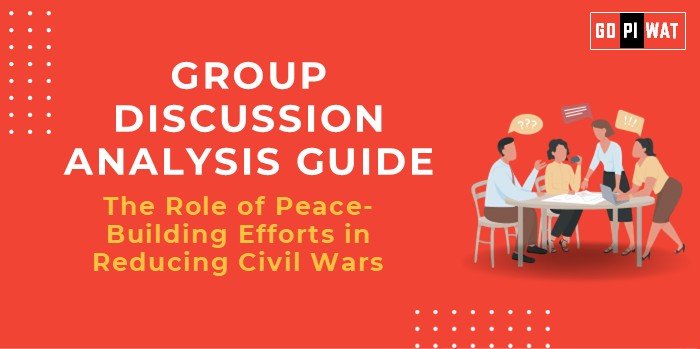📋 Group Discussion (GD) Analysis Guide
☮️ The Role of Peace-Building Efforts in Reducing Civil Wars
💡 Introduction to the Topic
🌱 Opening Context: Civil wars are among the most devastating forms of conflict, accounting for millions of deaths and displacements globally. Peace-building efforts aim to address root causes, rebuild societies, and prevent future conflicts.
📜 Topic Background: The concept of peace-building, first coined by UN Secretary-General Boutros Boutros-Ghali in 1992, encompasses post-conflict recovery, strengthening governance, and addressing structural inequalities. Recent cases like Rwanda and Sierra Leone highlight the effectiveness of sustained peace-building measures.
📊 Quick Facts and Key Statistics
- 🌍 Global Impact: 80% of conflicts post-1990 have been internal civil wars, underscoring the need for peace-building (UN Report 2023).
- 🚶 Displacement Crisis: Civil wars contributed to 43 million displaced individuals in 2022 (UNHCR).
- 💰 Economic Cost: Civil wars cost global GDP approximately $300 billion annually (World Bank).
- 🔄 Post-Conflict Recidivism: 50% of countries experience renewed conflict within a decade without effective peace-building (UNDP).
🌍 Stakeholders and Their Roles
- 🏛️ United Nations: Leads international peacekeeping, funding, and monitoring efforts.
- 🌐 Local Governments: Implement policy reforms, rebuild infrastructure, and foster inclusion.
- 🤝 NGOs: Provide resources, education, and community engagement.
- 👥 Global Community: Ensures accountability and offers technical and financial support.
🏆 Achievements and Challenges
🌟 Achievements:
- ✔️ Rwanda: Transitioned from genocide in 1994 to a stable economy with 7% GDP growth through community-driven reconciliation.
- 📜 Colombia: Peace accord with FARC rebels reduced conflict fatalities by 90%.
- 🌟 Sierra Leone: Post-civil war recovery driven by governance reforms and international aid.
⚠️ Challenges:
- 🚧 Weak Governance: Exacerbates instability in post-conflict regions.
- 💸 Limited Funding: Inadequate coordination among stakeholders hinders efforts.
- ⚖️ Inequality: Exclusion of marginalized groups sustains grievances.
🌍 Global Comparisons:
- ✅ Success: Norway’s mediation model in Sri Lanka (pre-2009).
- ❌ Struggles: South Sudan, where peace agreements failed to prevent renewed violence.
✨ Structured Arguments for Discussion
- 💬 Supporting Stance: “Peace-building efforts have demonstrably reduced conflict recurrence by addressing core social and economic grievances.”
- ⚖️ Opposing Stance: “Without addressing systemic corruption and elite power struggles, peace-building efforts often falter.”
- 🔄 Balanced Perspective: “While peace-building achieves significant progress in stability and growth, it requires continuous global commitment to succeed.”
🎯 Effective Discussion Approaches
📖 Opening Approaches:
- 📜 “According to the UN, 50% of civil wars reignite within 10 years without peace-building, making this topic urgent.”
- 📚 “The success of Rwanda and the failure in South Sudan showcase the critical nuances of effective peace-building.”
🔄 Counter-Argument Handling:
- ✔️ “Acknowledging failures is important, but examples like Colombia show that sustained efforts yield long-term benefits.”
📈 Strategic Analysis of Strengths and Weaknesses
- 💪 Strengths: Proven track record in reconciliation and economic recovery.
- ⚠️ Weaknesses: Susceptibility to political manipulation and funding gaps.
- 💡 Opportunities: Integration of AI in conflict monitoring.
- 🚨 Threats: Rising nationalist sentiments undermining multilateral efforts.
📚 Connecting with B-School Applications
- 🌟 Real-World Applications: Suitable for projects in conflict resolution, governance, and international development.
- 💬 Sample Questions:
- “What role does economic development play in peace-building?”
- “Can AI enhance early warning systems for conflict prevention?”
- 📖 Insights for Students:
- Explore interdisciplinary solutions combining technology, policy, and community engagement.


